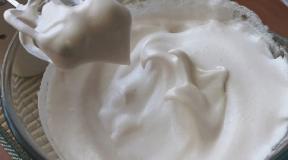Antibiotics drug classification. Antibiotics and their pharmacological action. Are antibiotics always effective?
Clinical and pharmacological characteristics
beta - lactam antibiotics
Penicillins, cephalosporins, carbapenems and monobactams have a β-lactam ring in their structure, which determines their strong bactericidal effect, and the possibility of cross-allergy development. Penicillins and cephalosporins can be inactivated by microorganisms (including intestinal flora) that produce the enzyme β-lactamase (penicillinase), which destroys the β-lactam ring. Due to the high clinical efficacy and low toxicity, β - lactam antibiotics occupy a leading place in the treatment of most infections.
Penicillins
Classification.
1. Natural (natural) penicillins- benzylpenicillins, phenoxymethylpenicillin and penicillins long acting (durant penicillins).
2. Semi-synthetic penicillins:
● isoxazolepenicillins - antistaphylococcal penicillins (oxacillin, cloxacillin, flucloxacillin);
● amidinopenicillins (amdinocillin, pivamdinocillin, bacamdinocillin, acidocillin);
● aminopenicillins - extended-spectrum penicillins (ampicillin, amoxicillin, talampicillin, bacampicillin, pivampicillin);
● antipseudomonal antibiotics:
- carboxypenicillins (carbenicillin, carphecillin, carindacillin, ticarcillin),
- ureidopenicillins (azlocillin, mezlocillin, piperacillin);
● inhibitor-protected penicillins (amoxicillin + clavulanic acid, ampicillin + sulbactam, ticarcillin + clavulanic acid, piperacillin + tazobactam).
Benzylpenicillins low toxicity and not expensive, create quickly high concentrations in many organs and tissues, including inside cells (therefore, they are a means emergency); worse penetrate into bone and nervous tissue, poorly penetrate the BBB. At the same time, with meningitis and hypoxic conditions of the brain, they can penetrate the BBB due to the inflammatory capillary vasodilation of cerebral vessels, and therefore are used to treat meningoencephalitis.
The sodium salt of benzylpenicillin is injected intramuscularly, intravenously, endolumbar (under the lining of the brain - intrathecal) and in the body cavity. Benzylpenicillin potassium and novocaine salt are administered only intramuscularly. Potassium salt should not be administered intravenously, since potassium ions released from the drug can cause depression of cardiac activity and convulsions. Novocaine salt of the drug is poorly soluble in water, forms suspensions with water and its ingress into the vessel is unacceptable.
The frequency of prescribing benzylpenicillins is 6 times a day (after 1 month of life), and the novocaine salt of the drug (benzylpenicillin procaine) - 2 times a day.
Phenoxymethylpenicillin (FOMP) It is acid-resistant and is used per os, but does not create high concentrations in the blood, therefore, it is not used for the treatment of severe infections. Usually FOMP is not used for monotherapy, but is combined with other antibiotics. For example, in the morning and in the evening, benzylpenicillin potassium salt is injected intramuscularly, and in the afternoon (2 - 3 times) FOMP is prescribed per os.
Prolonged penicillin preparations used for prophylactic purposes. Bicillin-1 (benzathine benzylpenicillin or benzathinepenicillin G) is poorly soluble in water, which is why it is used only for intramuscular administration 1 - 2 times a week. Bicillin - 3 is a combination of potassium or novocaine salts of benzylpenicillin with bicillin - 1 in equal proportions of 100 thousand units each. The drug is administered intramuscularly 1 - 2 times a week. Bicillin - 5 is also a combination of novocaine salt of benzylpenicillin and bicillin - 1 in a ratio of 1 to 4. Its intramuscular administration is performed once every 4 weeks.
Due to the slow absorption of Bicillin - 1, its action begins only 1 - 2 days after administration. Bicillins - 3 and - 5, due to the presence of benzylpenicillin in them, have an antimicrobial effect already in the first hours.
The most common side effect of natural penicillins is allergic reactions(anaphylactic shock is possible). Therefore, when prescribing drugs, it is necessary to carefully collect an allergic anamnesis and monitor the patient for 30 minutes. after the first injection of the drug. In some cases, skin tests are performed.
The drugs show antagonism with sulfonamides and synergism with aminoglycosides against gram-positive cocci (except pneumococci!), But are not compatible with them in the same syringe or in the same infusion system.
Isoxazolepenicillins(antistaphylococcal penicillins) are resistant to the action of penicillinase, i.e. they are active against penicillin-resistant strains of staphylococci- Staphylococcus aureus (PRSA), except methicillin-resistant strains of staphylococci (MRSA).PRSA - staphylococci play a major role in the problem nosocomial(nosocomial, hospital) infections... In relation to other microorganisms, the spectrum of their activity is the same as that of natural penicillins, but the antimicrobial effectiveness is much less. The drugs are administered both parenterally and orally 1 - 1.5 hours before meals, since they are not very resistant to hydrochloric acid.
Amidinopenicillins active against gram-negative enterobacteria. To increase their spectrum of action, these antibiotics are combined with isoxazolepenicillins and natural penicillins.
Aminopenicillins- broad spectrum antibiotics, but PRSA is resistant to them, which is why these drugs do not solve the problem of hospital infection. Therefore created combination drugs: ampiox (ampicillin + oxacillin), clonacom - P (ampicillin + cloxacillin), sultamicillin (ampicillin + sulbactam, which is a β - lactamase inhibitor), clonacom - X (amoxicillin + cloxacillin), augmentin + amoxicillin acid and its analogue amoxiculanic acid ).
Antipseudomonal penicillins are prescribed only in the absence of other anti-Pseudomonas aeruginosa drugs and only in the case of a confirmed sensitivity of the Pseudomonas aeruginosa to them, since they are toxic, and rapidly develops to them secondary(induced by the antibiotic itself) resistance pathogen. The drugs do not act on staphylococci. Therefore, if necessary, they are combined with isoxazolepenicillins. There are combination drugs: tymentin (ticarcillin + clavulanic acid) and tazocin (piperacillin + tazobactam as a β-lactamase inhibitor).
● Inhibitor-protected penicillins- combined preparations containing β - lactamase inhibitors (clavulanic acid, sulbactam, tazobactam). The most powerful of these is tazocin. These drugs are well distributed in the body, creating high concentrations in tissues and fluids (including the lungs, pleural and peritoneal cavities, middle ear, sinuses), but poorly penetrate the BBB. Acute liver damage is possible from clavulanic acid: increased transaminase activity, fever, nausea, vomiting.
Natural penicillins, isoxazolpenicillins, amidinopenicillins, aminopenicillins are low-toxic, have a wide range of therapeutic action. Only allergic reactions of both immediate and delayed types are dangerous in their treatment.
Carboxypenicillins and ureidopenicillins are drugs with a small latitude of therapeutic action, that is, drugs with a strict dosage regimen. Their use may be accompanied by the appearance of allergic reactions, symptoms of neuro - and hematotoxicity, nephritis, dysbiosis, hypokalemia.
All penicillins are incompatible with many substances, so they should be injected with a separate syringe.
Cephalosporins
These drugs are widely used in clinical practice, since they have a strong bactericidal effect, a wide therapeutic range, varying degrees of resistance to β - lactamases of staphylococci and low toxicity.
Broad spectrum antibiotics are the most sought after today drugs... They have earned such popularity due to their own versatility and ability to deal with several irritants at once that have a negative impact on human health.
Doctors do not recommend using such remedies without prior clinical research and without the recommendation of doctors. Irregular use of antibiotics can aggravate the situation and cause new diseases, as well as have a negative impact on human immunity.
New generation antibiotics
The risk of using antibiotics has been practically reduced to zero thanks to modern medical developments. New antibiotics have an improved formula and principle of action, thanks to which they active ingredients affect exclusively at the cellular level of the pathogenic agent, without disturbing the beneficial microflora of the human body. And if earlier such funds were used in the fight against a limited number of pathogenic agents, today they will be effective immediately against a whole group of pathogens.
Antibiotics are divided into the following groups:
- tetracycline group - tetracycline;
- a group of aminoglycosides - Streptomycin;
- amphenicol antibiotics - Chloramphenicol;
- penicillin series of drugs - Amoxicillin, Ampicillin, Bilmicin or Ticarcycline;
- antibiotics of the carbapenem group - Imipenem, Meropenem or Ertapenem.
The type of antibiotic is determined by the doctor after a thorough examination of the disease and investigation of all its causes. Treatment with the drug as prescribed by the doctor is effective and without complications.
Important: Even if the earlier use of one or another antibiotic helped you, this does not mean that if you experience similar or completely identical symptoms, you should take the same drug.
The best antibiotics for widespread use of the new generation
Tetracycline
Possesses the most a wide range applications;
What does tetracycline help from:
with bronchitis, tonsillitis, pharyngitis, prostatitis, eczema and various infections of the gastrointestinal tract and soft tissues.

Most effective antibiotic with chronic and acute diseases;
Country of origin - Germany (Bayer company);
The drug has a very wide range of applications and is included by the Ministry of Health of the Russian Federation in the list of essential medicines;
Virtually no side effects.
Amoxicillin

The most harmless and versatile drug;
It is used both for diseases with a characteristic increase in temperature, and for other diseases;
Most effective for:
- infections of the respiratory tract and ENT organs (including sinusitis, bronchitis, tonsillitis, otitis media);
- gastrointestinal infections;
- infections of the skin and soft tissues;
- infections of the genitourinary system;
- Lyme disease
- dysentery;
- meningitis;
- salmonellosis;
- sepsis.

Country of origin - Great Britain;
What does it help from?
bronchitis, tonsillitis, sinusitis, as well as various infections of the respiratory tract.
Amoxiclav

An effective drug with a very wide range of applications, practically harmless;
Main advantages:
- minimum of contraindications and side effects;
- pleasant taste;
- high-speed performance;
- does not contain dyes.

Fast-acting drug with a very wide range of applications;
Most effective in fighting infections that affect Airways, such as: angina, sinusitis, bronchitis, pneumonia. It is also used in the fight against infectious diseases of the skin and soft tissues, genitourinary, as well as in intestinal diseases.

Highly active against gram-negative microorganisms;
Country of origin - Russia;
It is most effective in the fight against gram-positive and gram-negative bacteria, mycoplasmas, legionella, salmonella, as well as sexually transmitted pathogens.
Avikaz

A fast-acting drug with virtually no side effects;
Country of origin - USA;
Most effective in treating diseases urinary tract and kidneys.

The device is distributed in ampoules (injections), one of the fastest-acting antibiotics;
Most effective drug during treatment:
- pyelonephritis and inf. urinary tract;
- infectious diseases of the small pelvis, endometritis, postoperative inf-ya and septic abortions;
- bacterial lesions of the skin and soft tissues, including diabetic foot;
- pneumonia;
- septicemia;
- abdominal infections.
Doriprex

Synthetic antimicrobial drug with bactericidal activity;
Country of origin - Japan;
This drug is most effective in treating:
- nosocomial pneumonia;
- severe intra-abdominal infections;
- complicated inf. urinary system;
- pyelonephritis, with a complicated course and bacteremia.
Classification of antibiotics by spectrum of action and purposes of use
Modern classification of antibiotics by groups: table
| Main group | Subclasses |
| Beta-lactams | |
| 1. Penicillins | Natural; Antistaphylococcal; Antipseudomonal; Spread spectrum; Inhibitor-protected; Combined. |
| 2. Cephalosporins | 4th generation; Anti-MRSA cephems. |
| 3. Carbapenems | - |
| 4. Monobactams | - |
| Aminoglycosides | Three generations. |
| Macrolides | Fourteen-member; Fifteen-membered (azoles); Sixteen-membered. |
| Sulfonamides | Short action; Average duration of action; Long-term action; Ultra-long; Local. |
| Quinolones | Non-fluorinated (1st generation); Second; Respiratory (3rd); Fourth. |
| Anti-tuberculosis | Main row; Reserve group. |
| Tetracyclines | Natural; Semi-synthetic. |
The following are the types of antibiotics of this series and their classification in the table.
| Group | By active substance isolate the preparation.: | Names |
| Natural | Benzylpenicillin | Benzylpenicillin Na and K salts. |
| Phenoxymethylpenicillin | Methylpenicillin | |
| With prolonged action. | ||
| Benzylpenicillin procaine | Benzylpenicillin novocaine salt. | |
| Benzylpenicillin / Benzylpenicillin procaine / Benzatin benzylpenicillin | Benzicillin-3. Bitsillin-3 | |
| Benzylpenicillin procaine / benzatin benzylpenicillin | Benzicillin-5. Bitsillin-5 | |
| Antistaphylococcal | Oxacillin | Oxacillin AKOS, sodium salt Oxacillin. |
| Penicillin-resistant | Cloxapcillin; Aluloxacillin. |
|
| Spread Spectrum | Ampicillin | Ampicillin |
| Amoxicillin | Flemoxin solutab, Ospamox, Amoxicillin. | |
| With antipseudomonal activity | Carbenicillin | Disodium salt of carbenicillin, Karfetsillin, Karindacillin. |
| Uriedopenicillins | ||
| Piperacillin | Picillin, Pipracil | |
| Azlocillin | Sodium salt of azlocillin, Securopen, Mezlocillin .. | |
| Inhibitor-protected | Amoxicillin / clavulanate | Ko-amoxiclav, Augmentin, Amoxiclav, Ranklav, Enkhantsin, Panklav. |
| Amoxicillin sulbactam | Trifamox IBL ,. | |
| Amlicillin / sulbactam | Sulacillin, Unazin, Ampisides. | |
| Piperacillin / tazobactam | Tazocin | |
| Ticarcillin / clavulanate | Tymentin | |
| Combination of penicillins | Ampicillin / Oxacillin | Ampiox. |
Antibiotics by time of action:
Groups of antibiotics and the names of the main drugs of the generation.
| Generations | Preparation: | Name |
| 1st | Cefazolin | Kefzol. |
| Cephalexin * | Cephalexin-AKOS. | |
| Cefadroxil * | Duroceph. | |
| 2nd | Cefuroxime | Zinacef, Cefurus. |
| Cefoxitin | Mefoxin. | |
| Cefotetan | Cefotetan. | |
| Cefaclora * | Ceclor, Wercef. | |
| Cefuroxime Axetila * | Zinnat. | |
| 3rd | Cefotaxime | Cefotaxime. |
| Ceftriaxone | Rofecin. | |
| Cefoperazone | Medocef. | |
| Ceftazidime | Fortum, Ceftazidime. | |
| Cefoperazone / sulbac-tama | Sulperazon, Sulzontsef, Bakperazon. | |
| Cefditorena * | Spectraceph. | |
| Cefixime * | Suprax, Sorcef. | |
| Cefpodoxime * | Proxetil. | |
| Ceftibutene * | Zedex. | |
| 4th | Cefepime | Maxipim. |
| Cefpirome | Keyten. | |
| 5th | Ceftobiprol | Zefter. |
| Ceftaroline | Zinforo. |
Antibiotics- a group of compounds of natural origin or their semi-synthetic and synthetic analogs with antimicrobial or antitumor effects.
To date, several hundreds of such substances are known, but only a few of them have found application in medicine.
Basic classifications of antibiotics
The basis for the classification of antibiotics there are also several different principles.
According to the method of obtaining them, they are divided:
- on natural;
- synthetic;
- semi-synthetic (at the initial stage they are obtained naturally, then the synthesis is carried out artificially).
Antibiotic producers:
- mostly actinomycetes and molds;
- bacteria (polymyxins);
- higher plants (phytoncides);
- tissues of animals and fish (erythrin, ektericide).
By the direction of action:
- antibacterial;
- antifungal;
- antineoplastic.
According to the spectrum of action - the number of types of microorganisms that antibiotics act on:
- broad-spectrum drugs (3rd generation cephalosporins, macrolides);
- drugs with a narrow spectrum of action (cycloserine, lincomycin, benzylpenicillin, clindamycin). In some cases, it may be preferable, since they do not suppress the normal microflora.
Chemical classification
By chemical structure antibiotics are divided:
- for beta-lactam antibiotics;
- aminoglycosides;
- tetracyclines;
- macrolides;
- lincosamides;
- glycopeptides;
- polypeptides;
- polyenes;
- anthracycline antibiotics.
The basis of the molecule beta-lactam antibiotics constitutes the beta-lactam ring. These include:
- penicillins are a group of natural and semi-synthetic antibiotics, the molecule of which contains 6-aminopenicillanic acid, consisting of 2 rings - thiazolidone and beta-lactam. Among them are:
Biosynthetic (penicillin G - benzylpenicillin);
- aminopenicillins (amoxicillin, ampicillin, becampicillin);
Semi-synthetic "antistaphylococcal" penicillins (oxacillin, methicillin, cloxacillin, dicloxacillin, flucloxacillin), the main advantage of which is resistance to microbial beta-lactamases, primarily staphylococcal;
- cephalosporins are natural and semi-synthetic antibiotics based on 7-aminocephalosporic acid and containing a cephem (also beta-lactam) ring,
that is, in structure they are close to penicillins. They are divided into hephalosporins:
1st generation - ceporin, cephalothin, cephalexin;
- 2nd generation - cefazolin (kefzol), cefamezin, cefaman-dol (mandol);
- 3rd generation - cefuroxime (ketocef), cefotaxime (claforan), cefuroxime axetil (zinnat), ceftriaxone (longa-cef), ceftazidime (fortum);
- 4th generation - cefepime, cefpirome (cefrom, keiten), etc.;
- monobactams - aztreones (azactam, nebactam);
- carbopenems - meropenem (meronem) and imipinem, used only in combination with a specific inhibitor of renal dehydropeptidase cilastatin - imipinem / cilastatin (thienam).
Aminoglycosides contain amino sugars linked by a glycosidic bond to the rest (aglycone fragment) of the molecule. These include:
- synthetic aminoglycosides - streptomycin, gentamycin (garamycin), kanamycin, neomycin, monomycin, sisomycin, tobramycin (tobra);
- semi-synthetic aminoglycosides - spectinomycin, amikacin (amikin), netilmicin (netillin).
The basis of the molecule tetracyclines constitutes a polyfunctional hydronaphthacene compound with the generic name tetracycline. Among them are:
- natural tetracyclines - tetracycline, oxytetracycline (clinimycin);
- semi-synthetic tetracyclines - metacyclin, chlortethrin, doxycycline (vibramycin), minocycline, rolitetracycline. Group drugs macrolide contain in their molecule a macrocyclic lactone ring associated with one or more carbohydrate residues. These include:
- erythromycin;
- oleandomycin;
- Roxithromycin (Rulid);
- azithromycin (sumamed);
- clarithromycin (klacid);
- spiramycin;
- dirithromycin.
TO lincosamide include lincomycin and clindamycin. Pharmacological and biological properties these antibiotics are very close to macrolides, and although chemically they are completely different drugs, some medical sources and pharmaceutical firms- manufacturers of chemical preparations, for example, delacin C, classify lincosamines as a macrolide group.
Group drugs glycopeptides contain substituted peptide compounds in their molecule. These include:
- vancomycin (vancacin, diatracin);
- teicoplanin (targotsid);
- daptomycin.
Group drugs polypeptides contain residues of polypeptide compounds in their molecule, these include:
- gramicidin;
- polymyxins M and B;
- bacitracin;
- colistin.
Group drugs irrigation contain several conjugated double bonds in their molecule. These include:
- amphotericin B;
- nystatin;
- levorin;
- natamycin.
To anthracycline antibiotics antineoplastic antibiotics include:
- doxorubicin;
- carminomycin;
- rubomycin;
- aclarubicin.
There are several more widely used antibiotics currently in practice that do not belong to any of the listed groups: fosfomycin, fusidic acid (fusidin), rifampicin.
The antimicrobial action of antibiotics, like other chemotherapeutic agents, is based on the violation of microbial cell metabolism.
The mechanism of antimicrobial action of antibiotics
By the mechanism of antimicrobial action antibiotics can be divided into the following groups:
- inhibitors of cell wall synthesis (murein);
- causing damage to the cytoplasmic membrane;
- suppressing protein synthesis;
- nucleic acid synthesis inhibitors.
To inhibitors of cell wall synthesis relate:
- beta-lactam antibiotics - penicillins, cephalosporins, monobactams and carbopenems;
- glycopeptides - vancomycin, clindamycin.
The mechanism of blockade of bacterial cell wall synthesis by vancomycin. differs from that of penicillins and cephalosporins and, accordingly, does not compete with them for binding sites. Since peptidoglycan is not present in the walls of animal cells, these antibiotics have very low toxicity to the microorganism, and they can be used in high doses (megatherapy).
To antibiotics that cause damage to the cytoplasmic membrane(blocking phospholipid or protein components, impaired permeability of cell membranes, changes in membrane potential, etc.) include:
- polyene antibiotics - have a pronounced antifungal activity, changing the permeability of the cell membrane by interacting (blocking) with the steroid components that make up it in fungi, and not in bacteria;
- polypeptide antibiotics.
The largest group of antibiotics is suppressing protein synthesis. Disruption of protein synthesis can occur at all levels, starting with the process of reading information from DNA and ending with interaction with ribosomes - blocking the binding of the transport t-RNA with the GOI-subunits of ribosomes (aminoglycosides), with 508-subunits of ribosomes (macro-leads) or with information i-RNA (tetracyclines on the 308-subunit of ribosomes). This group includes:
- aminoglycosides (for example, the aminoglycoside gentamicin, inhibiting protein synthesis in a bacterial cell, is capable of disrupting the synthesis of the protein coat of viruses and therefore may have an antiviral effect);
- macrolides;
- tetracyclines;
- chloramphenicol (chloramphenicol), which disrupts protein synthesis by a microbial cell at the stage of transferring amino acids to ribosomes.
Nucleic acid synthesis inhibitors possess not only antimicrobial, but also cytostatic activity and therefore are used as antineoplastic agents... One of the antibiotics belonging to this group, rifampicin, inhibits DNA-dependent RNA polymerase and thereby blocks protein synthesis at the transcriptional level.
Under the concept infectious diseases imply the body's response to the presence of pathogenic microorganisms or their invasion of organs and tissues, manifested by an inflammatory response. For treatment are used antimicrobial drugs, selectively acting on these microbes, with the aim of their eradication.
Microorganisms leading to infectious and inflammatory diseases in the human body are divided into:
- bacteria (true bacteria, rickettsia and chlamydia, mycoplasma);
- mushrooms;
- viruses;
- protozoa.
Therefore, antimicrobial agents are divided into:
- antibacterial;
- antiviral;
- antifungal;
- antiprotozoal.
It is important to remember that one drug can have several activities.
For example, Nitroxoline ®, prep. with a pronounced antibacterial and moderate antifungal effect - called an antibiotic. The difference between such a remedy and a "pure" antifungal agent is that Nitroxoline® has limited activity against some Candida species, but it has a pronounced effect against bacteria on which antifungal agent will not work at all.
In the 1950s, Fleming, Chain and Flory received the Nobel Prize in Medicine and Physiology for their discovery of penicillin. This event became a real revolution in pharmacology, completely overturning the basic approaches to the treatment of infections and significantly increasing the patient's chances of a complete and rapid recovery.
With the advent of antibacterial drugs, many diseases that caused epidemics that previously devastated entire countries (plague, typhus, cholera) have turned from a “death sentence” into a “disease that can be effectively treated” and now practically do not occur.
Antibiotics are substances of biological or artificial origin that can selectively inhibit the vital activity of microorganisms.
That is, distinctive feature their action is that they only affect the prokaryotic cell without damaging the cells of the body. This is due to the fact that there is no receptor target for their action in human tissues.
Antibacterial agents are prescribed for infectious and inflammatory diseases caused by the bacterial etiology of the pathogen or for severe viral infections, in order to suppress the secondary flora.
When choosing an adequate antimicrobial therapy, it is necessary to take into account not only the underlying disease and the sensitivity of pathogenic microorganisms, but also the patient's age, the presence of pregnancy, individual intolerance to the components of the drug, concomitant pathologies and the intake of prep. That are not combined with the recommended medication.
Also, it is important to remember that in the absence of a clinical effect from therapy within 72 hours, the drug is changed, taking into account the possible cross-resistance.
For serious infections or for purposes empirical therapy with unspecified pathogen, combination recommended different types antibiotics, taking into account their compatibility.
According to the effect on pathogens, there are:
- bacteriostatic - inhibiting the vital activity, growth and reproduction of bacteria;
- bactericidal antibiotics are substances that completely destroy the pathogen as a result of irreversible binding to the cellular target.
However, this division is rather arbitrary, since many antibes. can exhibit different activities, depending on the prescribed dosage and duration of use.
If the patient has recently used an antimicrobial agent, it should be avoided reapplication, at least six months - to prevent the emergence of antibiotic-resistant flora.
How does drug resistance develop?
Most often, resistance is observed due to mutation of the microorganism, accompanied by a modification of the target within the cells, which is affected by the types of antibiotics.
The active substance of the prescribed medium penetrates into the bacterial cell, but cannot contact the required target, since the principle of binding according to the "key-lock" type is violated. Consequently, the mechanism of suppression of activity or destruction of the pathological agent is not activated.
Others effective method defense against drugs is the synthesis of enzymes by bacteria that destroy the basic structures of antibiotics. This type of resistance most often occurs to beta-lactams, due to the production of beta-lactamases by the flora.
Much less common is an increase in resistance, due to a decrease in the permeability of the cell membrane, that is, the drug penetrates inside in too small doses to provide a clinically significant effect.
As a prevention of the development of drug-resistant flora, it is also necessary to take into account the minimum concentration of suppression, which expresses a quantitative assessment of the degree and spectrum of action, as well as dependence on time and concentration. in blood.
For dose-dependent drugs (aminoglycosides, metronidazole), the dependence of the effectiveness of the action on the concentr is characteristic. in the blood and the focus of the infectious and inflammatory process.
Time-dependent medications require reintroductions during the day, to maintain an effective therapeutic concentrate. in the body (all beta-lactams, macrolides).
Classification of antibiotics by mechanism of action
- drugs that inhibit the synthesis of the bacterial cell wall (antibiotics of the penicillin series, all generations of cephalosporins, Vancomycin ®);
- destroying the normal organization of the cell at the molecular level and interfering with the normal functioning of the tank membrane. cells (Polymyxin®);
- Wed-va, helping to suppress protein synthesis, inhibiting the formation of nucleic acids and inhibiting protein synthesis at the ribosomal level (Chloramphenicol preparations, a number of tetracyclines, macrolides, Lincomycin ®, aminoglycosides);
- inhibit. ribonucleic acids - polymerases, etc. (Rifampicin ®, quinols, nitroimidazoles);
- inhibiting the synthesis of folates (sulfonamides, diaminopyrides).
Classification of antibiotics by chemical structure and origin
1. Natural - waste products of bacteria, fungi, actinomycetes:
- Gramicidins ®;
- Polymyxins;
- Erythromycin ®;
- Tetracycline ®;
- Benzylpenicillins;
- Cephalosporins, etc.
2. Semi-synthetic - derivatives of natural antibiotics:
- Oxacillin®;
- Ampicillin®;
- Gentamicin ®;
- Rifampicin®, etc.
3. Synthetic, that is, obtained as a result of chemical synthesis:
- Levomycetin ®;
- Amikacin®, etc.
Classification of antibiotics by spectrum of action and purposes of use
| Acting mainly on: | Antibacterial products with a wide range of effects: | Anti-tuberculosis means | |
| Gram +: | Gram-: | ||
| biosynthetic penicillins and 1st generation cephalosporins; macrolides; lincosamides; drugs Vancomycin ®, Lincomycin ®. |
monobactams; cyclical. polypeptides; 3rd pok. cephalosporins. |
aminoglycosides; chloramphenicol; tetracycline; semi-synthetic extended spectrum penicillins (Ampicillin ®); 2nd pok. cephalosporins. |
Streptomycin ®; Rifampicin ®; Florimycin ®. |
Modern classification of antibiotics by groups: table
| Main group | Subclasses |
| Beta-lactams | |
| 1. Penicillins | Natural; Antistaphylococcal; Antipseudomonal; Spread spectrum; Inhibitor-protected; Combined. |
| 2. Cephalosporins | 4th generation; Anti-MRSA cephems. |
| 3. Carbapenems | — |
| 4. Monobactams | — |
| Aminoglycosides | Three generations. |
| Macrolides | Fourteen-member; Fifteen-membered (azoles); Sixteen-membered. |
| Sulfonamides | Short action; Average duration of action; Long-term action; Ultra-long; Local. |
| Quinolones | Non-fluorinated (1st generation); Second; Respiratory (3rd); Fourth. |
| Anti-tuberculosis | Main row; Reserve group. |
| Tetracyclines | Natural; Semi-synthetic. |
Not having subclasses:
- Lincosamides (Lincomycin®, Clindamycin®);
- Nitrofurans;
- Oxyquinolines;
- Chloramphenicol (this group of antibiotics is represented by Levomycetin ®);
- Streptogramins;
- Rifamycins (Rimactan®);
- Spectinomycin (Trobicin®);
- Nitroimidazoles;
- Antifolates;
- Cyclic peptides;
- Glycopeptides (vancomycin® and teicoplanin®);
- Ketolides;
- Dioxidine;
- Fosfomycin (Monural®);
- Fusidans;
- Mupirocin (Bactoban®);
- Oxazolidinones;
- Everninomycins;
- Glycylcyclines.
Antibiotic groups and drugs in the table
Penicillins
Like all beta-lactam drugs, penicillins have a bactericidal effect. They affect the final stage of the synthesis of biopolymers that form the cell wall. As a result of blocking the synthesis of peptidoglycans, due to the action on penicillin-binding enzymes, they cause the death of a pathological microbial cell.
The low level of toxicity to humans is due to the lack of target cells for antibiotics.
The mechanisms of bacterial resistance to these drugs have been overcome by the creation of protected agents fortified with clavulanic acid, sulbactam, etc. These substances suppress the action of the tank. enzymes and protect medicine from destruction.
Natural Benzylpenicillin Benzylpenicillin Na and K salts.
| Group | According to the active substance, the preparation is isolated: | Names |
| Phenoxymethylpenicillin | Methylpenicillin ® | |
| With prolonged action. | ||
| Benzylpenicillin procaine |
Benzylpenicillin novocaine salt ®. | |
| Benzylpenicillin / Benzylpenicillin procaine / Benzatin benzylpenicillin | Benzicillin-3®. Bicillin-3 ® | |
| Benzylpenicillin procaine / benzatin benzylpenicillin |
Benzicillin-5®. Bicillin-5 ® | |
| Antistaphylococcal | Oxacillin ® | Oxacillin AKOS ®, sodium salt of Oxacillin ®. |
| Penicillin-resistant | Cloxapcillin ®, Aluloxacillin ®. | |
| Spread Spectrum | Ampicillina ® | Ampicillin ® |
| Amoxicillin ® | Flemoxin Solutab ®, Ospamox ®, Amoxicillin ®. | |
| With antipseudomonal activity | Carbenicillin ® | Disodium salt of carbenicillin ®, Karfetsillin ®, Carindacillin ®. |
| Uriedopenicillins | ||
| Piperacillin ® | Picillin ®, Pipracil ® | |
| Azlocillin ® | Sodium salt of azlocillin®, Securopen®, Mezlocillin®. | |
| Inhibitor-protected | Amoxicillin / clavulanate ® | Ko-amoxiclav®, Augmentin®, Amoxiclav®, Ranklav®, Enkhantsin®, Panklav®. |
| Amoxicillin sulbactam ® | Trifamox IBL ®. | |
| Amlicillin / sulbactam ® | Sulacillin ®, Unazine ®, Ampisid ®. | |
| Piperacillin / tazobactam ® | Tazocin ® | |
| Ticarcillin / clavulanate ® | Tymentin ® | |
| Combination of penicillins | Ampicillin / Oxacillin ® | Ampiox ®. |
Cephalosporins
Due to their low toxicity, good tolerance, the ability to use for pregnant women, as well as a wide spectrum of action, cephalosporins are the most commonly used antibacterial agents in therapeutic practice.
The mechanism of action on the microbial cell is similar to that of penicillins, however, it is more resistant to the action of the tank. enzymes.
Rev. of the cephalosporin series have high bioavailability and good digestibility for any route of administration (parenteral, oral). Distributed well in internal organs(the exception is prostate), blood and tissues.
Only Ceftriaxone® and Cefoperazone® are capable of creating clinically effective concentrations in bile.
High level of permeability across the blood-brain barrier and efficacy in inflammation meninges, are noted in the third generation.
The only cephalosporin protected by sulbactam is Cefoperazone / sulbactam ®. It has an extended range of effects on flora due to its high resistance to the effects of beta-lactamases.
The table shows the groups of antibiotics and the names of the main drugs.
| Generations | Preparation: | Name |
| 1st | Cefazolinam | Kefzol ®. |
| Cephalexin ® * | Cephalexin-AKOS ®. | |
| Cefadroxil ® * | Durocef ®. | |
| 2nd | Cefuroxime ® | Zinacef ®, Cefurus ®. |
| Cefoxitin ® | Mefoxin ®. | |
| Cefotetana ® | Cefotetan ®. | |
| Cefaclora ® * | Ceclor ®, Wercef ®. | |
| Cefuroxime-axetila ® * | Zinnat ®. | |
| 3rd | Cefotaxime ® | Cefotaxime ®. |
| Ceftriaxone ® | Rofecin ®. | |
| Cefoperazone ® | Medocef ®. | |
| Ceftazidime ® | Fortum ®, Ceftazidime ®. | |
| Cefoperazone / sulbactam ® | Sulperazon ®, Sulzontsef ®, Bakperazon ®. | |
| Cefditorena ® * | Spectraceph ®. | |
| Cefixime ® * | Suprax ®, Sorcef ®. | |
| Cefpodoxime ® * | Proxetil ®. | |
| Ceftibutene ® * | Zedex ®. | |
| 4th | Cefepime ® | Maxipim ®. |
| Cefpirome ® | Keyten ®. | |
| 5th | Ceftobiprol ® | Zefter ®. |
| Ceftaroline ® | Zinforo ®. |
* They have an oral form of release.
Carbapenems
They are reserve drugs and are used to treat severe nosocomial infections.
Highly resistant to beta-lactamases, effective for the treatment of drug-resistant flora. In life-threatening infectious processes, they are the primary means for the empirical scheme.
Allocate the teacher:
- Doripenem® (Doripresx®);
- Imipenema ® (Tienam ®);
- Meropenem ® (Meronem ®);
- Ertapenema ® (Invanz ®).
Monobactams
- Aztreonam ®.
Rev. has a limited range of applications and is prescribed to eliminate inflammatory and infectious processes associated with Gram bacteria. Effective in the treatment of infections. processes of the urinary tract, inflammatory diseases of the pelvic organs, skin, septic conditions.
Aminoglycosides
The bactericidal effect on microbes depends on the level of concentration of the medium in biological fluids and is due to the fact that aminoglycosides disrupt the processes of protein synthesis on the ribosomes of bacteria. Have enough high level toxicity and many side effects, however, rarely cause allergic reactions. Practically ineffective when taken orally, due to poor absorption in the gastrointestinal tract.
Compared to beta-lactams, the rate of passage through tissue barriers is much worse. They do not have therapeutically significant concentrations in bones, cerebrospinal fluid and bronchial secretions.
| Generations | Preparation: | Bargain. title |
| 1st | Kanamycin ® | Kanamycin-AKOS ®. Kanamycin monosulfate ®. Kanamycin sulfate ® |
| Neomycin ® | Neomycin sulfate ® | |
| Streptomycin ® | Streptomycin sulfate ®. Streptomycin-calcium chloride complex ® | |
| 2nd | Gentamicin ® | Gentamicin ®. Gentamicin-AKOS ®. Gentamicin-K ® |
| Netilmicin ® | Netromycin ® | |
| Tobramycin ® | Tobrex ®. Brulamycin ®. Nebtsin ®. Tobramycin ® | |
| 3rd | Amikacin ® | Amikacin ®. Amikin ®. Selemycin ®. Hemacin ® |
Macrolides
Provide inhibition of the growth and reproduction of pathogenic flora, due to the suppression of protein synthesis on the ribosomes of cells. walls of bacteria. With an increase in dosage, they can have a bactericidal effect.
Also, there are combined prep .:
- Pilobact ® is a complex medium for the treatment of Helicobacter pylori. Contains clarithromycin®, omeprazole® and tinidazole®.
- Zenerit ® is a medium for external use, for the treatment of acne. The active ingredients are erythromycin and zinc acetate.
Sulfonamides
They inhibit the growth and reproduction of pathogens due to structural similarity with para-aminobenzoic acid, which is involved in the life of bacteria.
Have high rate resistance to its action in many representatives of Gram-, Gram +. Used in composition complex therapy rheumatoid arthritis, retain good antimalarial activity, are effective against Toxoplasma.
Classification:
For topical use, silver sulfathiazole (Dermazin®) is used.
Quinolones
Due to inhibition of DNA hydrases, they have a bactericidal effect, are concentration-dependent media.
- The first generation includes non-fluorinated quinolones (nalidixic, oxolinic and pipemidic acids);
- Second pok. represented by Gram-means (Ciprofloxacin®, Levofloxacin®, etc.);
- The third is the so-called respiratory aids. (Levo- and Sparfloxacin®);
The fourth is St. with anti-anaerobic activity (Moxifloxacin ®).
Tetracyclines
Tetracycline ®, whose name was given to a separate group of antibiotics, was first obtained chemically in 1952.
The active substances of the group are: metacyclin®, minocycline®, tetracycline®, doxycycline®, oxytetracycline®.
On our site you can get acquainted with most of the groups of antibiotics, complete lists drugs included in them, classifications, history and other important information. For this, a section "" has been created in the top menu of the site.
Antibiotic - a substance "against life" - a drug that is used to treat diseases caused by living agents, usually various pathogenic bacteria.
Antibiotics are divided into many types and groups for a variety of reasons. The classification of antibiotics makes it possible to most effectively determine the scope of application of each type of drug.
1. Depending on the origin.
- Natural (natural).
- Semi-synthetic - on initial stage The substance is produced from natural raw materials, and then they continue to artificially synthesize the drug.
- Synthetic.
Strictly speaking, antibiotics proper are only drugs obtained from natural raw materials. All other medicines are called "antibacterial drugs". V modern world the term "antibiotic" means all types of drugs that can fight living pathogens.
What are natural antibiotics made from?
- from molds;
- from actinomycetes;
- from bacteria;
- from plants (phytoncides);
- from fish and animal tissues.
2. Depending on the impact.
- Antibacterial.
- Antineoplastic.
- Antifungal.
3. According to the spectrum of influence on a particular number of different microorganisms.
- Antibiotics with a narrow spectrum of action.
These drugs are preferable for treatment, since they act specifically on a certain type (or group) of microorganisms and do not suppress the healthy microflora of the patient's body. - Antibiotics with a wide range of effects.
4. By the nature of the effect on the cell of bacteria.
- Bactericidal drugs - destroy pathogens.
- Bacteriostatics - they stop the growth and reproduction of cells. Subsequently the immune system the body must independently cope with the bacteria remaining inside.
5. By chemical structure.
For those who study antibiotics, the classification by chemical structure is decisive, since the structure of the drug determines its role in the treatment of various diseases.
1. Beta-lactam drugs
1. Penicillin is a substance produced by colonies of molds of the Penicillinum species. Natural and artificial derivatives of penicillin have a bactericidal effect. The substance destroys the cell walls of bacteria, which leads to their death.
Disease-causing bacteria adapt to drugs and become resistant to them. The new generation of penicillins is supplemented with tazobactam, sulbactam and clavulanic acid, which protect the drug from destruction inside bacteria cells.
Unfortunately, penicillins are often perceived by the body as an allergen.
Penicillin antibiotic groups:
- Naturally occurring penicillins are not protected from penicillinase, an enzyme produced by modified bacteria that breaks down the antibiotic.
- Semi-synthetics - resistant to bacterial enzyme:
biosynthetic penicillin G - benzylpenicillin;
aminopenicillin (amoxicillin, ampicillin, becampicellin);
semi-synthetic penicillin (drugs methicillin, oxacillin, cloxacillin, dicloxacillin, flucloxacillin).
2. Cephalosporin.
It is used in the treatment of diseases caused by bacteria resistant to the effects of penicillins.
Today, 4 generations of cephalosporins are known.
- Cefalexin, cefadroxil, ceporin.
- Cefamezin, cefuroxime (axetil), cefazolin, cefaclor.
- Cefotaxim, ceftriaxone, ceftizadim, ceftibuten, cefoperazone.
- Cefpirome, cefepime.
Cephalosporins also cause allergic reactions in the body.
Cephalosporins are used in surgical interventions to prevent complications, in the treatment of ENT diseases, gonorrhea and pyelonephritis.
2. Macrolides
They have a bacteriostatic effect - they prevent the growth and division of bacteria. Macrolides act directly on the site of inflammation.
Among modern antibiotics macrolides are considered the least toxic and give a minimum of allergic reactions.
Macrolides accumulate in the body and are applied in short courses of 1-3 days. They are used in the treatment of inflammation of the internal ENT organs, lungs and bronchi, infections of the pelvic organs.
Erythromycin, Roxithromycin, Clarithromycin, Azithromycin, Azalides and Ketolides.
3. Tetracycline
A group of drugs of natural and artificial origin. They have a bacteriostatic effect.
Use tetracyclines in treatment severe infections: brucellosis, anthrax, tularemia, respiratory and urinary tract. The main drawback of the drug is that bacteria adapt very quickly to it. Tetracycline is most effective for topical application in the form of ointments.
- Natural tetracyclines: tetracycline, oxytetracycline.
- Semisentite tetracyclines: chlortethrin, doxycycline, metacyclin.
4. Aminoglycosides
Aminoglycosides are highly toxic bactericidal drugs that are active against gram-negative aerobic bacteria.
Aminoglycosides quickly and effectively destroy pathogenic bacteria, even with weakened immunity. To start the mechanism of destruction of bacteria, aerobic conditions are required, that is, antibiotics of this group do not "work" in dead tissues and organs with poor circulation (cavities, abscesses).
Aminoglycosides are used in the treatment of the following conditions: sepsis, peritonitis, furunculosis, endocarditis, pneumonia, bacterial kidney damage, urinary tract infections, inflammation of the inner ear.
Aminoglycoside preparations: streptomycin, canamycin, amikacin, gentamicin, neomycin.
5. Levomycetin
A drug with a bacteriostatic mechanism of action on bacterial pathogens. It is used to treat serious intestinal infections.
An unpleasant side effect of treatment with chloramphenicol is defeat bone marrow, in which there is a violation of the process of production of blood cells.
6. Fluoroquinolones
Preparations with a wide range of effects and a powerful bactericidal effect. The mechanism of action on bacteria is to disrupt DNA synthesis, which leads to their death.
Fluoroquinolones are used for topical treatment of the eyes and ears, due to the strong side effect... The drugs affect the joints and bones, are contraindicated in the treatment of children and pregnant women.
Fluoroquinolones are used against the following pathogens: gonococcus, shigella, salmonella, cholera, mycoplasma, chlamydia, pseudomonas aeruginosa, legionella, meningococcus, mycobacterium tuberculosis.
Drugs: levofloxacin, gemifloxacin, sparfloxacin, moxifloxacin.
7. Glycopeptides
An antibiotic of a mixed type of action on bacteria. In relation to most species, it has a bactericidal effect, and in relation to streptococci, enterococci and staphylococci, it has a bacteriostatic effect.
Glycopeptide preparations: teicoplanin (targocid), daptomycin, vancomycin (vancacin, diatracin).
8. Anti-tuberculosis antibiotics
Preparations: ftivazid, metazid, salusid, ethionamide, prothionamide, isoniazid.
9. Antibiotics with antifungal effect
They destroy the membrane structure of fungal cells, causing their death.
10. Antileprosy drugs
Used for the treatment of leprosy: solusulfone, diucifon, diaphenylsulfone.
11. Antineoplastic drugs - anthracycline
Doxorubicin, rubomycin, carminomycin, aclarubicin.
12. Lincosamides
According to their medicinal properties very close to macrolides, although chemical composition Is a completely different group of antibiotics.
Drug: Delacin S.
13. Antibiotics that are used in medical practice, but do not belong to any of the known classifications.
Fosfomycin, fusidin, rifampicin.
Table of drugs - antibiotics
Classification of antibiotics by groups, the table distributes some types of antibacterial drugs depending on the chemical structure.
| Group of drugs | Drugs | Scope of application | Side effects |
| Penicillin | Penicillin. Aminopenicillin: ampicillin, amoxicillin, becampicillin. Semisynthetic: methicillin, oxacillin, cloxacillin, dicloxacillin, flucloxacillin. |
Antibiotic with a wide range of effects. | Allergic reactions |
| Cephalosporin | 1st generation: Cephalexin, cefadroxil, seporin. 2: Cefamezin, cefuroxime (axetil), cefazolin, cefaclor. 3: Cefotaxime, ceftriaxone, ceftizadim, ceftibuten, cefoperazone. 4: Cefpirome, cefepime. |
Surgical operations (to prevent complications), ENT diseases, gonorrhea, pyelonephritis. | Allergic reactions |
| Macrolides | Erythromycin, Roxithromycin, Clarithromycin, Azithromycin, Azalides, and Ketolides. | ENT organs, lungs, bronchi, pelvic infections. | Least toxic, do not cause allergic reactions |
| Tetracycline | Tetracycline, oxytetracycline, chlortethrin, doxycycline, metacyclin. |
Brucellosis, anthrax, tularemia, respiratory and urinary tract infections. | Quickly addictive |
| Aminoglycosides | Streptomycin, kanamycin, amikacin, gentamicin, neomycin. | Treatment of sepsis, peritonitis, furunculosis, endocarditis, pneumonia, bacterial kidney damage, urinary tract infections, inflammation of the inner ear. | High toxicity |
| Fluoroquinolones | Levofloxacin, Gemifloxacin, Sparfloxacin, Moxifloxacin. | Salmonella, gonococcus, cholera, chlamydia, mycoplasma, Pseudomonas aeruginosa, meningococcus, shigella, legionella, mycobacterium tuberculosis. | Affects the musculoskeletal system: joints and bones. Contraindicated in children and pregnant women. |
| Levomycetin | Levomycetin | Intestinal infections | Bone marrow damage |
The main classification of antibacterial drugs is based on their chemical structure.



















